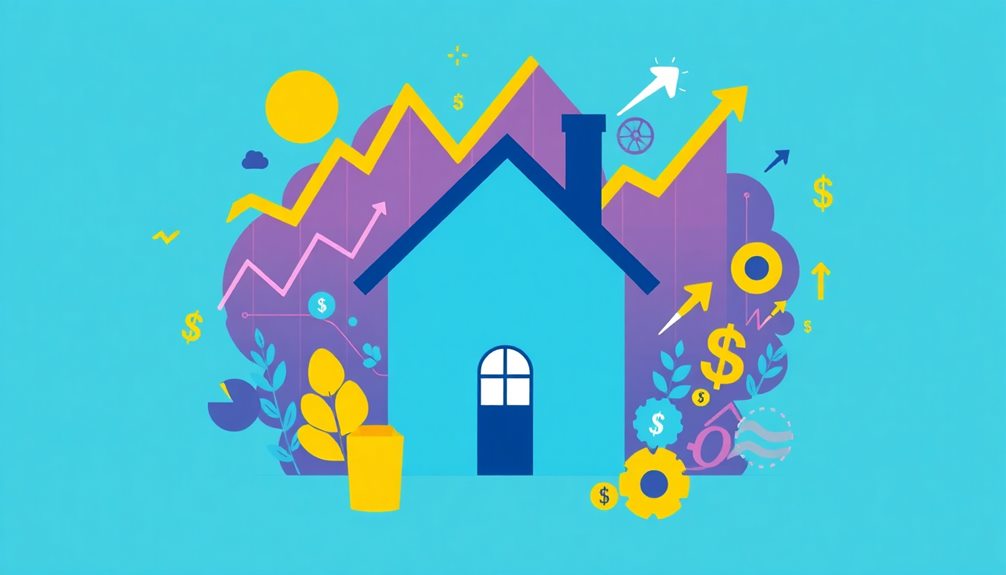A Home Equity Line of Credit (HELOC) lets you tap into your home's equity, providing flexible financing options for various needs. You can borrow up to 85% of your home's value, minus your existing mortgage. The HELOC has two phases: a 10-year draw period where you only pay interest and a repayment period lasting 10 to 20 years, requiring both principal and interest payments. Since interest rates are variable, your monthly payments may change. This financing method can be used for home improvements or debt consolidation, making it a convenient choice. Learn more about its advantages and potential risks.
Key Takeaways
- A Home Equity Line of Credit (HELOC) allows borrowing against home equity, providing flexible financing options for various needs.
- HELOCs feature a draw period for interest-only payments followed by a repayment period requiring both principal and interest payments.
- Interest rates on HELOCs are variable, influenced by the prime rate, leading to fluctuating monthly payments.
- Borrowers can access up to 85% of their home equity, offering significant cash availability for projects or emergencies.
- Interest on HELOCs may be tax-deductible if used for qualified home improvements, potentially lowering overall borrowing costs.
Understanding Home Equity Lines

When it comes to accessing the wealth tied up in your home, a Home Equity Line of Credit (HELOC) can be a smart option. This revolving credit allows you to borrow against the equity built in your home, typically up to 85% of your home's total value minus any existing mortgage balance.
The HELOC structure consists of two distinct phases: the draw period and the repayment period. During the draw period, which usually lasts ten years, you can access funds and make interest-only payments, offering flexibility in your financial situation.
After the draw period, you'll enter the repayment period, lasting between ten to twenty years, where you'll need to make principal and interest payments. It's essential to recognize that HELOC interest rates are often variable, influenced by the prime rate, which can lead to fluctuating monthly payments.
To qualify for a HELOC, you generally need a minimum credit score of around 620 and a debt-to-income ratio below 43%. If you use the HELOC funds for qualified home-related projects, you may even benefit from a tax deduction on those interest payments.
Benefits of HELOC Financing

When you consider a Home Equity Line of Credit (HELOC), you'll find several key benefits that can work to your advantage.
With lower interest rates compared to unsecured loans, flexible borrowing options, and potential tax deductions, this financial tool can help you manage expenses more effectively.
Whether you're funding a renovation or consolidating debt, a HELOC might be the right choice for you.
Lower Interest Rates
With lower interest rates compared to unsecured loans, a Home Equity Line of Credit (HELOC) can be a smart financial tool for homeowners. HELOC rates are typically more favorable, allowing you to borrow against your homes at a lower cost. Since these rates are often variable and linked to the prime rate, you can enjoy reduced interest payments in a stable or declining interest rate environment.
You can access credit limits up to 85% of your home equity, giving you significant access to cash when needed. Plus, if you use your HELOC for qualified home improvements, the interest you pay may even be tax-deductible, further lowering your overall borrowing costs.
Here's a quick comparison of HELOC benefits:
| Benefit | Description |
|---|---|
| Lower Interest Rates | Generally lower than unsecured loans |
| Access to Cash | Up to 85% of your home equity |
| Tax-Deductible Interest | Potential deduction on qualified improvements |
| Variable Interest | Linked to prime rate, can decrease over time |
| Promotional Rates | Special rates during the draw period |
Utilizing a HELOC can be a cost-effective way to finance your needs.
Flexible Borrowing Options
A Home Equity Line of Credit (HELOC) offers homeowners unparalleled flexibility in borrowing, making it an ideal solution for various financial needs. With a HELOC, you can borrow money against your home equity—up to 85%—providing flexible access to funds for anything from home improvements to debt consolidation.
During the draw period, typically lasting 10 years, you can make interest-only payments, which lowers your monthly costs while still tapping into your credit line as needed.
One of the major benefits of a HELOC is the lower interest rates compared to unsecured loans, thanks to it being secured by your home. This makes it an attractive option for larger expenses, whether you're funding education, making major purchases, or setting aside emergency funds.
With a HELOC, you can easily incorporate this borrowing method into your financial planning. It allows you to access cash as needed while managing repayment effectively.
Plus, if you use the funds for qualifying home improvements, the interest paid may even be tax-deductible, adding to the overall financial advantages. Embrace the versatility a HELOC offers and make the most of your home's equity.
Potential Tax Deductions
Understanding the financial benefits of a Home Equity Line of Credit (HELOC) goes beyond just flexible borrowing options; it can also provide potential tax deductions that enhance your overall savings. The interest paid on a HELOC may be tax-deductible if you use the funds for qualifying home improvements that substantially increase your home's value. However, remember that these tax deductions are subject to IRS guidelines.
To benefit from HELOC interest deductions, you'll need to itemize deductions on your tax return. Note that the IRS limits the deductibility of interest on loans—up to $750,000 for married couples filing jointly or $375,000 for single filers. Since tax benefits vary based on your financial situations, consulting with a tax advisor is essential for compliance and maximizing deductions.
Additionally, keeping detailed records of how you spend your HELOC funds can help substantiate your claims during tax filing.
| Criteria | Married Couples | Single Filers |
|---|---|---|
| Max Loan Amount | $750,000 | $375,000 |
| Qualifying Improvements | Yes | Yes |
| Itemize Deductions Required | Yes | Yes |
| Consult Tax Advisor Recommended | Yes | Yes |
| Maintain Detailed Records | Yes | Yes |
HELOC Versus Home Equity Loans

When deciding between a Home Equity Line of Credit (HELOC) and a home equity loan, it's crucial to evaluate how each option aligns with your financial needs.
A HELOC functions as a revolving credit line, allowing you to borrow against your home equity as needed. This option typically has a draw period of around 10 years, where you can access funds and make interest-only payments. After that, you'll enter a repayment period lasting 10 to 20 years, requiring both principal and interest payments.
On the other hand, home equity loans provide a lump sum with fixed interest rates, resulting in predictable monthly payments. This makes them ideal for larger, one-time expenses.
While HELOCs often come with variable interest rates that can fluctuate, affecting your monthly payments, home equity loans maintain stability throughout their term.
Both options let you borrow against your home equity and use your property as collateral. However, remember that failing to make payments on either can lead to foreclosure.
You can typically access up to 85% of your home equity with a HELOC, while home equity loans usually allow borrowing up to 80%.
How to Qualify for a HELOC

Qualifying for a Home Equity Line of Credit (HELOC) involves meeting specific financial criteria set by lenders. First, you'll need a minimum credit score of around 620. Higher scores can secure you better interest rates and terms.
Additionally, understanding how fees can impact your overall financial strategy is vital when considering flexible options like a HELOC, especially when related to investments such as a Gold IRA. Next, your debt-to-income (DTI) ratio should ideally be 43% or lower, as lenders use this to evaluate your repayment capability.
Additionally, you must have sufficient home equity, typically between 15% to 20% of your home's value. This means your outstanding mortgage balance should be markedly less than your property's current market value.
To determine this value, lenders usually require a property appraisal, which plays an essential role in deciding your credit limit.
When applying, be prepared to submit essential documentation, including proof of income, W-2s, and mortgage statements. These documents help lenders assess your financial health and guarantee you can manage the flexible financing options a HELOC offers.
HELOC Draw and Repayment Phases

Maneuvering the HELOC draw and repayment phases is essential for managing your finances effectively. During the draw period, which typically lasts 10 years, you can access funds up to your credit limit, making interest-only payments. This flexibility allows you to withdraw cash as needed, similar to using a credit card.
However, once this draw period ends, you shift into the repayment phase, which spans 10 to 20 years.
In the repayment phase, your monthly payments will increase considerably, as you'll need to start paying both principal and interest. This alteration can require budget adjustments, so it's important to plan ahead.
Keep in mind that interest rates on HELOCs are often variable, meaning your payments can fluctuate based on changes in the prime rate. This variability can impact overall repayment costs, making it essential to stay informed about your HELOC's terms.
Interest Rates and Economic Influences

Understanding how interest rates affect your HELOC is vital for making informed financial decisions. HELOC interest rates are typically variable, meaning they can fluctuate based on market conditions and are often tied to the prime rate plus a lender-specific margin. Economic factors like inflation and Federal Reserve policies directly influence prime rates, impacting the rates offered on your HELOC.
Additionally, just as with investments like a Gold IRA, where tax implications can affect your overall financial strategy, the cost of borrowing against your home equity can also be influenced by shifting economic conditions.
When you're borrowing against your home equity, remember that lenders may adjust HELOC rates periodically. This means your monthly payments can vary considerably over time. Borrowers with higher credit scores generally qualify for better rates, so maintaining a score in the mid-600s or above can be beneficial.
It's also essential to compare offers from multiple lenders. Some may provide promotional rates that are lower than standard market rates, giving you the chance to save on interest costs.
Risks Associated With HELOCS

While maneuvering interest rates is important for managing your HELOC, it's equally essential to recognize the risks that come with this type of borrowing. One major concern is the risk of foreclosure; since HELOCs are secured by your home, defaulting can put your property at stake.
Additionally, HELOCs often come with variable interest rates, meaning your monthly payments can fluctuate unpredictably, leading to financial strain.
Market fluctuations can also lead to negative equity, where you owe more than your home's current value. This situation can cause significant financial difficulties if you need to sell.
Moreover, the easy access to credit can encourage overspending, leading to an accumulation of debt that may spiral out of control, especially if you don't practice responsible usage.
Don't forget about closing costs, which can add an extra 2% to 5% to your overall expenses. It's vital to factor these costs into your budget and guarantee you can handle the monthly payments, both during the draw period and when the repayment phase begins.
Understanding these risks can help you make informed decisions about how to use your HELOC responsibly.
Tax Implications of HELOCs

Tax implications can greatly impact your decision to use a Home Equity Line of Credit (HELOC). The interest you pay on a HELOC may be tax-deductible if you use the borrowed funds for qualified expenses, such as home improvements, according to IRS guidelines.
To qualify for this deduction, you must guarantee that the funds are used to buy, build, or substantially improve the home securing the HELOC.
To benefit from potential tax deductions, you'll need to itemize your deductions on your tax return. Keep in mind that tax deductibility limits can vary based on your individual circumstances and any changes in tax law.
It's wise to consult with a tax professional who can provide personalized guidance tailored to your situation.
Maintaining accurate records of how you use your HELOC funds is essential. This documentation can support your deduction claims during tax filing, confirming you can validate your eligibility for tax benefits.
Alternatives to Home Equity Financing

Exploring alternatives to home equity financing can open up various pathways for accessing funds without the risks associated with borrowing against your home. One option is cash-out refinancing, where you replace your existing mortgage with a new, larger one to tap into your equity, often at lower interest rates than home equity loans.
Additionally, understanding your IRA investment strategy can provide insights into diversifying your funding options and maximizing your financial resources.
For smaller expenses or projects, personal loans are a viable choice, offering fixed rates and terms without needing home collateral, which reduces your risk. You can also consider credit cards for quick access to funds, though keep in mind they typically carry higher interest rates.
Additionally, government programs from the FHA or USDA can provide assistance with home improvements and repairs, allowing you to secure funding without tapping into your home equity.
Lastly, using your savings or emergency funds as a first line of defense for financial needs can help you avoid increasing debt and the costs of borrowing against your home.
Frequently Asked Questions
What Is the Monthly Payment on a ,000 Home Equity Line of Credit?
Your monthly payment on a $50,000 home equity line of credit typically ranges from $125 to $290 during the draw period. After that, payments may jump considerably, depending on your remaining balance and interest rates.
What Is Flexible Financing Options?
Flexible financing options are like a safety net for your finances, allowing you to borrow as needed. They provide access to funds for emergencies or projects, helping you manage unexpected costs and improve your financial flexibility.
What Is the Downside of a HELOC?
A HELOC's downsides include foreclosure risk if you miss payments, variable interest rates that can spike, the temptation to overspend, and higher repayment costs that can strain your budget if not managed wisely.
What Is a Home Equity Flex Loan?
Think of a Home Equity Flex Loan as your financial toolkit. It lets you draw funds like a HELOC while offering fixed-rate options, so you can manage payments and access equity with ease and flexibility.
Conclusion
In the landscape of home financing, a HELOC shines like a beacon, offering flexibility and access to funds when you need them most. It's a tool that can help you sculpt your financial future, but be mindful of the risks lurking in the shadows. By understanding the ins and outs of HELOCs, you can navigate this path confidently, ensuring you don't get lost in the maze of interest rates and repayment terms. Your home's equity can be a powerful ally.










